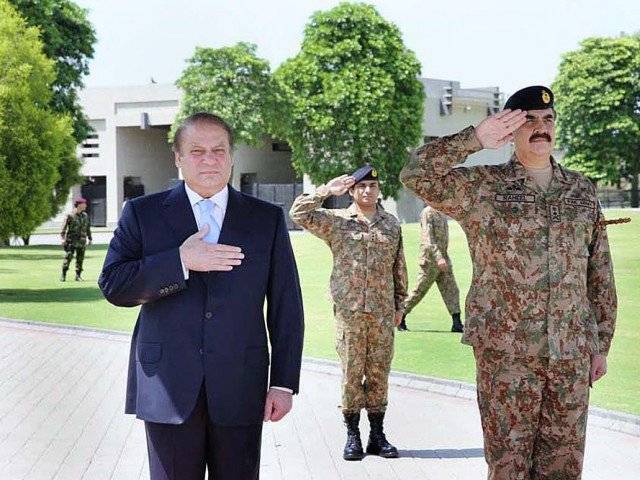It is now time to bring some further nuance to analysis of Pakistan’s politics, foreign and security policies, and the civil-military paradigm under which it is normally scrutinized. Prime Minister Narendra Modi’s visit to Lahore, if analyzed carefully, will crystalise what everyone has been missing about the civil-military tug of war.
Everytime a Pakistani civilian government is cut down to size, hits a hurdle in taking forward its security or foreign policies, or is destabilized, the powerful military establishment, known as the boyzes, is seen as the player to have done it. The military establishment is generally seen as a disciplined monolithic institution that acts as one. Not so.
Informed by two incidents of the past, I can be certain that the controversy around Mr. Modi’s visit to Lahore on Friday is evidence the military does not always act as one. Considering at first the Bangkok summit between the National Security Advisors of India and Pakistan, then the Heart of Asia conference and resumption of peace initiative with both India and Afghanistan, and now Prime Minister Modi’s visit to Pakistan, it is obvious as noonday sun that Pakistan’s military chief General Raheel Sharif is completely supportive of making peace with the two neighbours. It is clear that Gen Sharif is in partnership with Prime Minister Nawaz Sharif to normalize relationships with the neighbours and help bring prosperity to the country. He is also actively supporting the economic corridor with China, and committing troops in Balochistan to provide security for the incoming investment. He is also supporting the political settlement in Balochistan to this and other ends, to end the insurgency in Balochistan.
Yet one sees journalists, television anchors and social media accounts associated with the ‘boyzes’ trying to run a spoke in the wheel, and denigrating Prime Minister Modi’s Christmas day visit. This had a senior journalist clearly puzzled, which speaks volumes for the fact that generally the military’s aims, policies and actions thought of as unanimous. Clearly, that is not the case. The military’s premier agency has demonstrated in the past that it has a mind and agenda of its own, and will cross the powerful military chief in its own ways. And this is what explains tweets from ‘senior journalists’ such as: “Strong earthquake in Kabul and Islamabad. India’s PM Modi was in both places today. He’s famously known to jinx his hosts”, “(to Modi) Sorry, bro. But the only thing we are celebrating today is the birthday of the Quaid. Hope you liked the pakoras” and “Narendra Modi let whole of Pakistan dance into a ‘simple harmonic motion’ leading to worst earthquake; God this was literally hell”; it also explains further bile from other ‘senior television anchors’ opposing any peace overtures towards India. These ‘journalists’ continue to be the master’s voice. Since the military has traditionally used the ISI to control electronic media, the ISI is able to get away with its own agenda, even when it runs counter to the military chief’s.
To illustrate this assertion with facts from the past, the hawaldar media (military controlled journalists and anchors) first egged the then military dictator General Pervez Musharraf to clean up the Laal Masjid, after its khateeb established a parallel government in Islamabad in 2007. After operation cleanup, the same anchors began to call for Musharraf’s blood, calling the killed militants ‘innocent girls’ and ‘innocent kids’. The switch was stunning. But guess who were the media handlers? The ISI. It was headed by General Ashfaq Pervez Kayani at the time (who went on to inherit the mantle of military chief after Gen Musharraf’s fall). One anchor is on record as having said, ‘we were told to keep Mush tight on spot.’ And there you have evidence of the ISI working against the military chief.
The second episode that bears testimony to my assertion also relates to the same year: the military chief and dictator General Musharraf was encouraged by the then ISI head General Ashfaq Pervez Kayani in 2007 to go after the then Chief Justice of the Country, CJ Iftikhar Chaudhry. On the other hand, General Kayani assured Justice Iftikhar Chaudhry of his support and to dig in his heels against the military dictator. Helped by other factors, he achieved his aim and Musharraf quit his uniform and Kayani was sworn in in November of 2007 as the army chief.
Kayani left the ISI in the hands of his own man, General Shuja Pasha, who later left it in the hands of his own man, General Zaheer ul Islam, in 2012. Now fast forward to 2014 and Mr. Imran Khan’s sit ins. Once again these were supported by the ISI, and the government was at the brink of collapse. Here too, it is public knowledge that the military chief and the ISI were not on the same page. But Gen Sharif could not risk a coup from within coming out to bat for PM Sharif too publicly or too strongly. The government only stabilized after the ISI coterie of five generals retired from service and Imran Khan was left dangling on his container. He was ordered off the container after the Army Public School attack and he obediently heeled once he knew his support was gone.
It is no wonder then, that now despite General Raheel Sharif’s support of the peace processes, the ‘hawaldar media’ is denigrating it. But lest anyone confuse the whole thing again, let it be clear that it looks like a repeat of the ISI running its own agenda as opposed to the army chief’s.






